Portrait mode elevates your social media photos by simulating the shallow depth of field typical of professional cameras. It creates a blurred background effect, known as bokeh, while keeping your subject in sharp focus. This technique reduces distractions, enhances visual appeal, and creates a dreamy, artistic atmosphere. Portrait mode also improves the separation between foreground and background, increasing the perception of depth in your images. It highlights facial features, brightens eyes, and smooths blemishes, adding a professional polish to your shots. By mastering portrait mode, you'll capture visually striking images that stand out in your followers' feeds. Discover how to make the most of this powerful feature and transform your social media presence.
Understanding Portrait Mode

Portrait mode revolutionizes smartphone photography by simulating the shallow depth of field typically achieved with professional cameras. It uses a combination of hardware and software to create a blurred background effect, known as bokeh, while keeping the subject in sharp focus. This technique draws attention to the main subject, making it stand out from its surroundings.
When you activate portrait mode, your phone's camera system analyzes the scene, identifying the foreground subject and separating it from the background. It then applies a selective blur to the background elements, creating a professional-looking image with a striking sense of depth. The intensity of this blur can often be adjusted after taking the photo, allowing you to fine-tune the effect to your liking.
Portrait mode isn't just for human subjects; it can enhance photos of pets, objects, and even food. By creating visual separation between the subject and its environment, you'll capture more visually appealing images that naturally draw the viewer's eye.
This feature has become increasingly sophisticated, with some smartphones now offering additional lighting effects and adjustable aperture simulations to further enhance your portraits.
Blurring Backgrounds for Impact
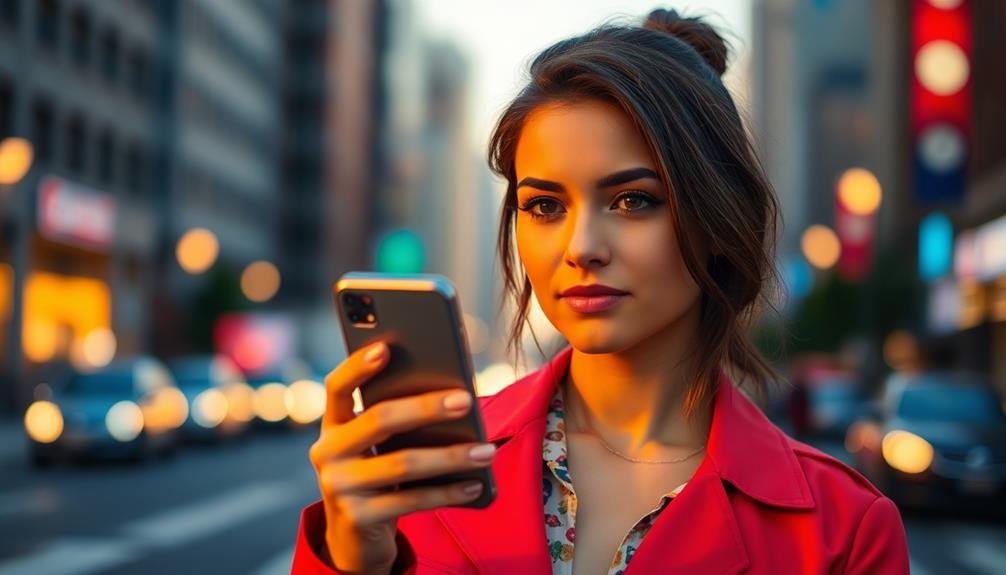
Backgrounds play an essential role in enhancing the impact of your portrait photos. By blurring the background, you'll create a striking contrast that draws attention to your subject. This technique, known as bokeh, can transform an ordinary snapshot into a professional-looking image.
When you use portrait mode to blur backgrounds, you'll achieve several benefits:
- Reduced distractions from busy environments
- Enhanced focus on your subject's features
- Creation of a dreamy, artistic atmosphere
- Improved separation between foreground and background
- Increased perception of depth in your photos
To make the most of background blurring, consider the distance between your subject and the background. The further apart they are, the more pronounced the blur effect will be.
Experiment with different aperture settings if your camera allows it, as wider apertures create a shallower depth of field.
Remember that not all backgrounds should be completely blurred. Sometimes, leaving recognizable elements slightly out of focus can add context to your image while still maintaining the emphasis on your subject.
Practice different levels of blur to find the perfect balance for each photo you take.
Highlighting Your Subject
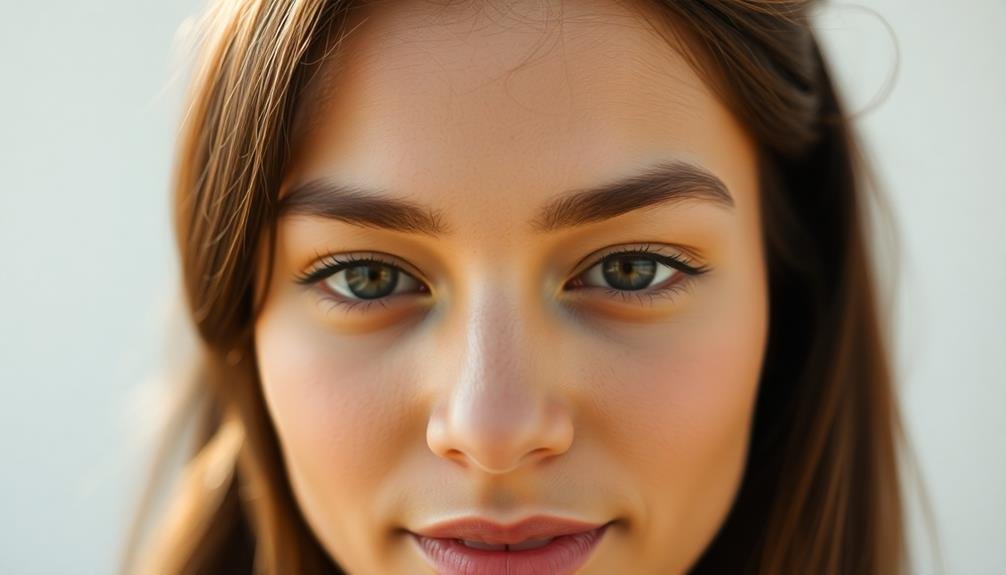
Portrait mode's ability to highlight your subject goes beyond just blurring backgrounds.
You'll notice enhanced facial features that make your subject pop, drawing viewers' attention right where you want it.
This improved compositional focus guarantees your social media photos stand out and capture the essence of your subject effectively.
Blurred Backgrounds
One of the most striking features of portrait mode is the ability to create a beautifully blurred background, also known as bokeh.
This effect instantly elevates your social media photos by drawing attention to your subject and creating a professional-looking image. The blurred background separates your subject from the surrounding environment, making them stand out and appear more three-dimensional.
When using portrait mode for blurred backgrounds, keep these tips in mind:
- Choose a background with varied colors or light sources for a more interesting bokeh effect
- Maintain some distance between your subject and the background
- Experiment with different aperture settings if your camera allows it
- Use natural light when possible for softer, more flattering results
- Position your subject off-center for a more dynamic composition
Enhanced Facial Features
Many portrait mode features go beyond blurring backgrounds to enhance facial features, making your subject look their best. These advanced algorithms can subtly improve skin tone, smooth out blemishes, and even adjust facial contours.
You'll notice that portrait mode often brightens eyes, sharpens facial details, and enhances overall complexion. When you're capturing portraits for social media, these enhancements can make a significant difference.
Portrait mode can add a touch of professional polish to your photos, helping your subject stand out and look more photogenic. It's like having a personal touch-up artist built into your camera.
However, it's important to use these features judiciously. While they can improve your photos, overuse can lead to an unnatural appearance. Aim for subtle enhancements that maintain your subject's authentic look.
You'll want to preserve their unique features and expressions while gently refining the overall image.
Improved Compositional Focus
Focusing on your subject becomes effortless with portrait mode's improved compositional techniques. This feature automatically isolates your main subject, creating a striking visual hierarchy that guides viewers' eyes directly to the most important elements of your photo. By blurring the background and sharpening the foreground, portrait mode guarantees that you're always the star of your social media shots.
Portrait mode's compositional benefits extend beyond simple background blur. It enhances your photos by:
- Creating depth and dimension
- Minimizing distracting elements
- Improving overall image balance
- Highlighting intricate details
- Producing a professional-looking result
You'll find that portrait mode simplifies the process of capturing visually appealing images. It eliminates the need for complex camera settings or extensive post-processing. Instead, you can focus on your pose, expression, and framing, confident that the technology will handle the technical aspects of composition.
This allows you to experiment with different angles and poses without worrying about losing focus on your subject. Whether you're taking selfies or having a friend photograph you, portrait mode consistently delivers polished, attention-grabbing results that are sure to stand out in crowded social media feeds.
Creating Depth in Photos

When using portrait mode, you'll want to focus on creating depth in your photos.
Start by clearly separating your foreground subject from the background, which helps draw attention to the main focus of your image.
You can then manipulate the bokeh effect to enhance this separation, adjusting the level of background blur to achieve the perfect balance between your subject and their surroundings.
Foreground and Background Separation
The key to a stunning portrait mode photo lies in effectively separating the foreground from the background.
This separation creates depth and draws attention to your subject, making your social media photos more visually appealing. To achieve this effect, you'll need to focus on creating a clear distinction between your main subject and the surrounding elements.
When using portrait mode, consider these factors to enhance foreground and background separation:
- Distance: Position your subject farther from the background
- Lighting: Use contrasting light on your subject and background
- Color: Choose complementary or contrasting colors for added separation
- Depth of field: Adjust aperture settings for a blurred background
- Composition: Frame your subject with negative space
Bokeh Effect Manipulation
Manipulating the bokeh effect is a powerful way to create depth in your portrait mode photos. By adjusting the level of background blur, you can control how much attention is drawn to your subject.
Increase the bokeh for a dreamy, ethereal look that makes your subject pop, or reduce it for a more natural appearance that maintains context.
You can fine-tune the bokeh effect by adjusting the f-stop or aperture settings in your camera app. A lower f-stop (like f/1.8) creates a more pronounced bokeh, while a higher f-stop (like f/5.6) results in less blur.
Experiment with different settings to find the perfect balance for your shot.
Don't forget to reflect on the distance between your subject and the background. The further your subject is from the background, the more pronounced the bokeh effect will be.
You can also play with lighting to enhance the bokeh, as bright spots in the background will create beautiful, blurred circles of light.
Adjusting Lighting for Portraits
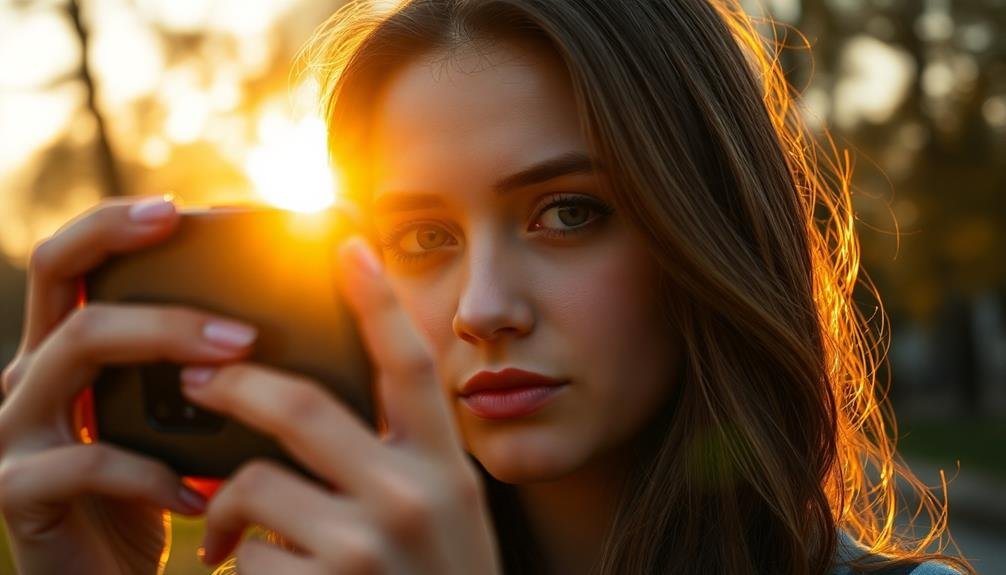
Lighting often makes or breaks a portrait photo. When you're using portrait mode for social media, adjusting the lighting can greatly enhance your images.
You'll want to take into account both natural and artificial light sources to create the perfect ambiance for your portrait. Start by positioning your subject facing a light source. This could be a window for natural light or a lamp for indoor shots.
Avoid harsh overhead lighting, as it can create unflattering shadows. Instead, aim for soft, diffused light that evenly illuminates the face.
Here are five key lighting tips for portrait mode photos:
- Use the golden hour (just after sunrise or before sunset) for warm, flattering light
- Experiment with side lighting to add depth and dimension
- Try backlighting for a dreamy, ethereal effect
- Use a reflector or white surface to bounce light onto shadowy areas
- Adjust your phone's exposure settings to fine-tune the overall brightness
Framing Techniques for Portrait Mode
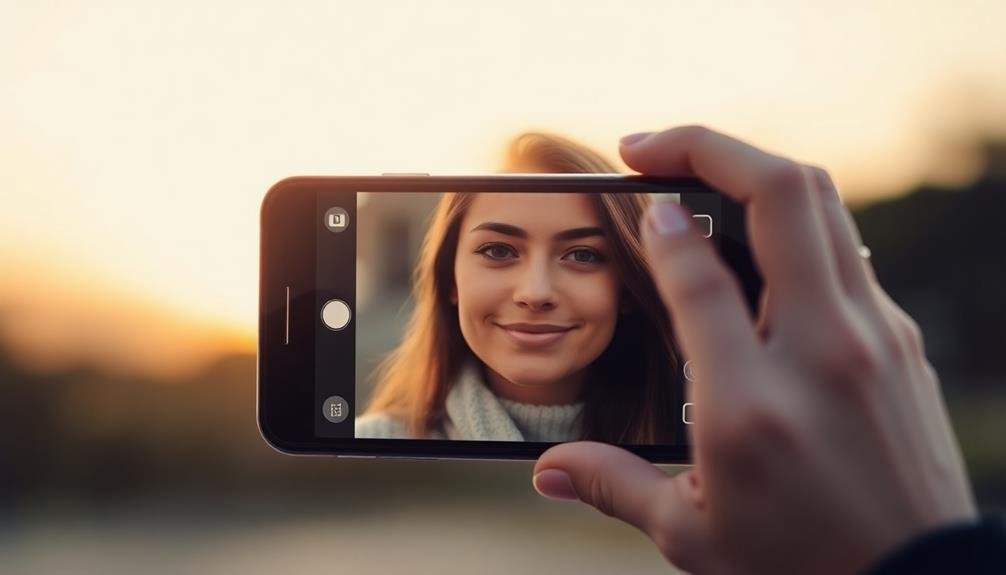
When using portrait mode for social media photos, mastering framing techniques can elevate your images.
You'll want to apply the rule of thirds, placing your subject off-center for a more dynamic composition.
Additionally, you can incorporate leading lines to draw the viewer's eye towards your subject, creating a more engaging and visually appealing portrait.
Rule of Thirds
For decades, photographers have relied on the Rule of Thirds to create visually appealing compositions. This principle is equally valuable when using Portrait Mode for your social media photos.
Imagine dividing your frame into a 3×3 grid, with two horizontal and two vertical lines. The key points of interest in your image should align with these lines or their intersections.
When applying the Rule of Thirds to Portrait Mode photos, consider these tips:
- Position your subject's eyes along the top horizontal line
- Place the face at one of the vertical lines
- Align the horizon with either the top or bottom horizontal line
- Use negative space to create balance in the composition
- Experiment with off-center framing for a more dynamic look
Leading Lines Composition
How can you make your Portrait Mode photos even more enchanting? Enter the world of leading lines composition. This powerful technique draws the viewer's eye to your subject, creating depth and visual interest in your portraits.
To utilize leading lines effectively, look for natural or man-made elements that form paths or directions within your frame. These lines can be straight, curved, or even implied. Position your subject where these lines converge or lead to, creating a visual journey for the viewer.
Consider these examples of leading lines in Portrait Mode:
| Natural Lines | Man-made Lines |
|---|---|
| Tree branches | Fences |
| Shorelines | Railway tracks |
| River paths | Staircases |
| Mountain ridges | Urban streets |
When composing your shot, experiment with different angles and perspectives to emphasize these lines. You might need to crouch, stand on a chair, or move around to find the perfect alignment.
Selecting Ideal Locations
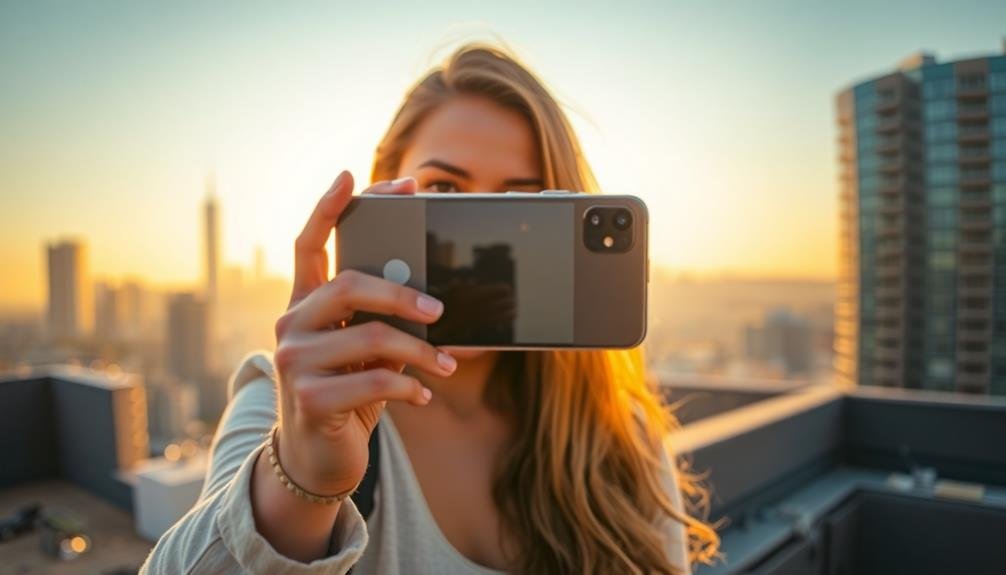
Choosing the perfect backdrop for your portrait mode photos can elevate your social media game. When selecting ideal locations, consider both the subject and the overall aesthetic you're aiming for.
Look for places that offer depth and texture, as these elements enhance the portrait mode effect. Natural settings like parks, beaches, or forests can provide beautiful, soft backgrounds that won't overpower your subject.
Urban environments can also be excellent choices, offering interesting architectural elements or street art as backdrops. Pay attention to lighting conditions, as they'll greatly impact your photo's mood and quality. Experiment with different times of day to capture the best light for your chosen location.
Here are five types of locations that work well for portrait mode photos:
- Gardens with lush foliage
- Colorful murals or graffiti walls
- Historic buildings with unique architectural features
- Scenic overlooks with expansive views
- Bustling cityscapes with blurred lights in the background
Remember to scout locations in advance and consider factors like crowd levels and potential distractions.
Posing Tips for Portrait Mode
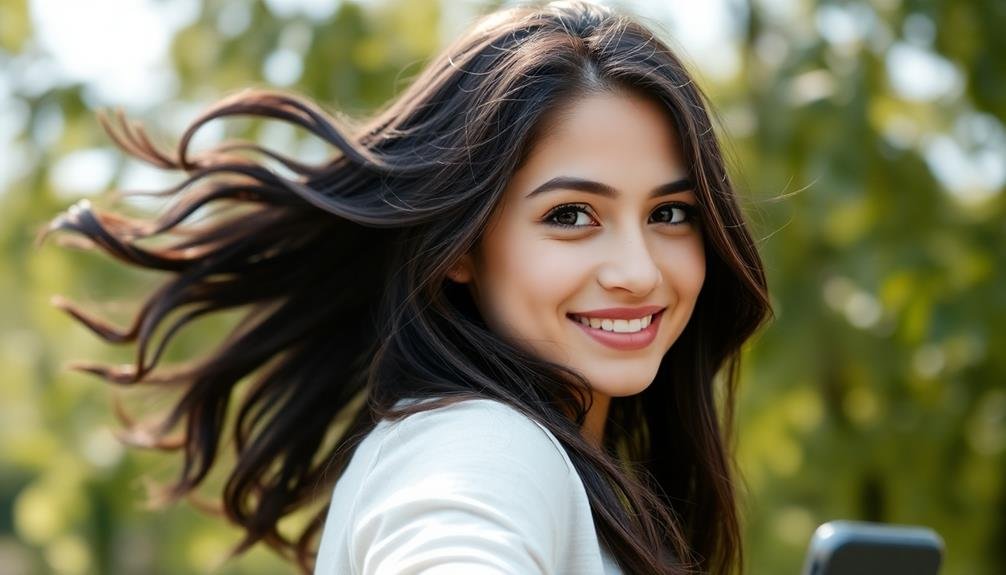
With portrait mode photos, mastering the art of posing can make or break your social media content. To nail your portrait shots, start by finding your best angle. Turn your face slightly to one side and tilt your chin down a bit to create a more flattering jawline. Keep your shoulders relaxed and angled away from the camera to avoid appearing stiff.
For full-body shots, create a sense of movement by shifting your weight onto one leg and placing your hand on your hip. This classic S-curve pose adds dimension to your silhouette. When sitting, cross your legs or angle them to one side for a more dynamic look.
Don't forget about your hands – they can add expression to your photos. Try touching your face gently, running your fingers through your hair, or holding a prop relevant to your content. Experiment with different facial expressions, from a subtle smile to a more serious, contemplative look.
Remember to maintain good posture throughout your shoot. Stand tall, pull your shoulders back, and elongate your neck. This will help you appear more confident and photogenic in your portrait mode snapshots.
Editing Portrait Mode Photos

Once you've captured the perfect portrait mode photo, it's time to elevate it with some strategic editing. Start by adjusting the basic elements like brightness, contrast, and saturation to enhance the overall look. Pay special attention to the subject's skin tones, ensuring they appear natural and flattering.
Next, focus on fine-tuning the depth-of-field effect. Many portrait mode apps allow you to adjust the blur intensity and area. Experiment with these settings to create a more realistic or dramatic background blur, depending on your preference.
Consider these additional editing techniques to enhance your portrait mode photos:
- Use selective adjustments to highlight specific areas
- Apply subtle vignettes to draw attention to the subject
- Experiment with color grading to create a unique mood
- Remove distracting elements with spot healing tools
- Enhance details in the eyes and hair for added impact
Remember to maintain a consistent editing style across your social media photos to create a cohesive aesthetic.
Don't overdo the edits; aim for a natural, polished look that enhances the subject's features without appearing artificial.
With practice, you'll develop your own editing style that perfectly complements your portrait mode shots.
Best Apps for Portrait Mode

While many smartphones now come with built-in portrait mode features, dedicated apps can take your photos to the next level. If you're looking to enhance your portrait shots, consider these top-rated options:
Focos is a powerful app that lets you adjust depth of field, bokeh effects, and even add lighting after you've taken the photo. It's perfect for fine-tuning your portraits.
For Android users, AfterFocus offers similar capabilities, allowing you to create a professional-looking blur effect with ease.
Snapseed, available for both iOS and Android, provides a range of editing tools, including a selective focus feature that mimics portrait mode. It's great for adjusting specific areas of your image.
VSCO is another popular choice, offering film-inspired presets and advanced editing tools to give your portraits a unique look.
For a more artistic approach, try Prisma or Artisto. These apps use AI to transform your photos into stylized works of art, perfect for creating eye-catching social media posts.
Frequently Asked Questions
Can Portrait Mode Be Used for Non-Human Subjects?
Yes, you can use portrait mode for non-human subjects. It's great for pets, plants, and objects. You'll get a blurred background effect that makes your subject stand out. Try it on flowers or your favorite collectibles.
How Does Portrait Mode Affect Battery Life on Smartphones?
When you're using portrait mode, it'll drain your battery faster than normal shooting. It's processing more data and using multiple cameras. You'll notice the impact, especially during extended photo sessions. Consider carrying a power bank.
Are There Any Drawbacks to Using Portrait Mode?
You'll find some drawbacks to portrait mode. It can struggle with complex subjects, blur important details, and create unnatural-looking edges. You're also limited in editing options, and it's not ideal for all types of photos.
Can Portrait Mode Be Applied to Existing Photos?
You can't apply true portrait mode to existing photos. However, you'll find apps and editing tools that simulate the effect. They'll blur the background artificially, but results may vary compared to real-time portrait mode captures.
Does Portrait Mode Work Equally Well on All Smartphone Models?
Portrait mode doesn't work equally well on all smartphones. You'll find that newer, high-end models typically offer better results. However, many mid-range phones now include decent portrait modes. It's best to test your specific device's capabilities.
In Summary
You've now got the tools to take your social media photos to the next level with portrait mode. It's time to put these tips into practice. Experiment with different backgrounds, poses, and lighting. Don't be afraid to try new locations and editing techniques. Remember, the key is highlighting your subject while creating depth and impact. With practice, you'll soon be capturing stunning portraits that'll make your social media feed stand out from the crowd.





Leave a Reply